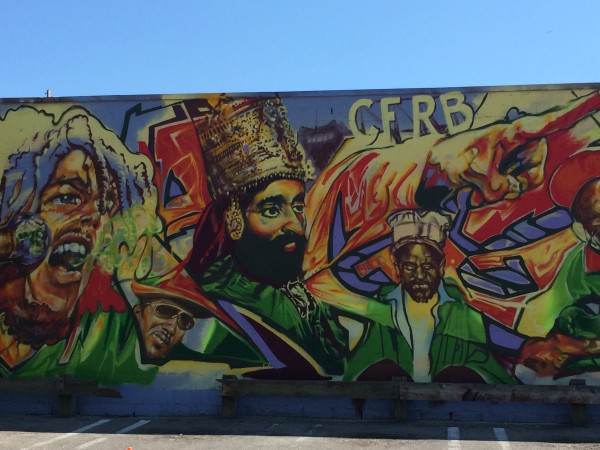At the Jack Layton Ferry Terminal on Queen’s Quay West, a colourful, 80-foot mosaic stretches the length of the pedestrian walkway. Fragments of glass, tile and mirror meticulously depict a series of shoreline images inspired by harbourfront history.
The mosaic was designed and created in 2012 by 18 emerging youth artists from priority neighbourhoods across Toronto through the organization Arts for Children and Youth (AFCY). The mural was funded partially through StreetARToronto (StART), a City program that provides grants, promotion, and development for street art projects. Until recently, an offshoot of that program, RE StART, was targeted toward education and opportunities specifically for young and emerging artists. But in February 2016, when StART begins accepting grant applications, RE StART likely won’t be re-launched.
According to Lillie Zendel, project manager for StreetARToronto, any organization applying for a grant is encouraged to include young artists in their project, but there will be no program directed specifically toward youth. When RE StART was launched a decade ago, it was run out of the City’s Employment and Social Services sector, where it focused primarily on youth employment. When it was taken over by Transportation Services, it began to focus on street art and graffiti management.
“With the street art, some of it was good and some of it wasn’t,” says Zendel. “We don’t want to ignore our commitment to youth, but the project has to be artist-led. We want to focus on artist quality. We do want youth to be involved but we want them to receive some serious training.”
Julie Frost, executive director of AFCY, says it’s “essential” to involve youth muralists in city development.
“They provide the public a diverse voice and a perspective that’s often unique. It’s unique but it’s also needed in the discussions we have as city planners and cultural makers,” she says. “They have so much artistic agency that needs to be demonstrated and showcased.”
There are practical consequences for having a younger demographic involved too. “These projects provide jobs for our youth,” she says. “There’s huge issues with poverty and lack of jobs for young people. We see this all the time in the news. That’s a demographic that’s suffering greatly.” Frost says their projects often work with youth who “identify with the margins,” and come from underserviced parts of the city.
Sustainable Thinking and Expressions on Public Space (STEPS), is a Toronto-based organization that promotes artistic transformations of public space, and often works with young artists. In the summer of 2013, a group of youth involved with their Emerging ARTivists program — along with local residents — created a 32-storey mural on the side of a TCHC apartment building in St. Jamestown. The mural, at 200 Wellesley Street, depicts a giant phoenix rising the full height the complex. That project was funded partially by StreetARToronto, as were three other STEPS initiatives, including the transformation of a derelict laneway in Thorncliffe Park into a mixed media installation. A fourth project, a mural gracing the newly-designated Reggae Lane at Oakwood and Eglinton, was unveiled earlier this month.
There are many benefits to having youth engaged in public art projects, says Anjuli Solanki, program manager for the Emerging ARTivists initiative. “One of the biggest things is that it really builds self confidence, knowing they can have a voice and an impact on public space,” she says. “It really changes the way they see themselves and the way the community treats them.”
But finding funding for these projects isn’t always easy. “It’s fairly challenging,” says Solanki, estimating that 70% of the organization’s work involves searching for funding and grants. “Art in the public space, especially when it involves mentorship, is consistently undervalued.”
As it stands, it is not a mandatory stipulation for a anyone applying for StreetARToronto to have youth involved in the project, but Zendel says it’s still an important component that may affect the granting decision.
“Organizations that demonstrate robust youth engagement, improve the likelihood of being recommended,” she says.
Having both professional and young artists at work in the city is important, says Frost. “They compliment each other. But there has to be that voice of youth on the streets.”
Photo by Vadim Taraskine





One comment
Toronto needs a lot more street art but it needs new blood, most of the visible pieces are done by a small handful of artists who due to their networks get all the work.
It’s clearly not fair and Toronto’s street art scene suffers for it.